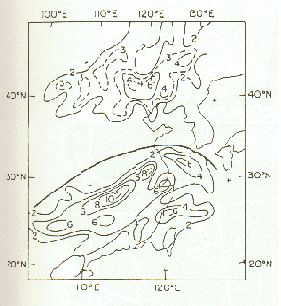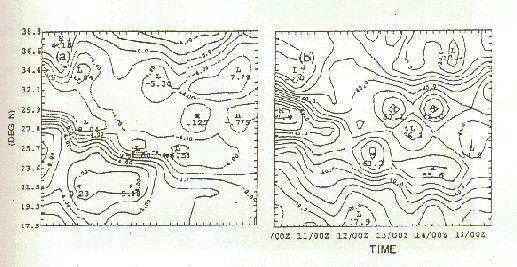Some Important Mesoscale Features in HUAMEX
George Tai-Jen Chen
Department of Atmospheric Sciences
National Taiwan University
Taipei, Taiwan (ROC)
1. Introduction
Mei-Yu front established its quasi-stationary position over South
China and Taiwan in the period of mid-May to mid-June. The
seasonal rainfall distribution reaches a maximum during this
period primarily due to the repeated occurrence of the Mei-Yu
front. The mean position of Mei-Yu front migrates northward to
the Yangtze River Valley in the period of mid-June to mid-July
and leads to the ``traditional'' Chinese Mei-Yu season over central
China. Heavy rain / flash flood in the Mei-Yu season is one of the
most serious meteorological disasters over Taiwan. To better
understand the mesoscale processes responsible for heavy rain,
the National Science Council of the ROC on Taiwan established a
ten-year program ``Taiwan Area Mesoscale Experiment (TAMEX)''
(Chen 1985; Chen and Shieh 1993). The field phase of TAMEX was
carried in May-June 1987 (Wu and Chen 1987; Kuo and Chen
1990). Chen (1992) discussed the mesoscale features observed in
the Taiwan Mei-Yu season. These include Mei-Yu front, low level
jet (LLJ), mesoscale convective systems (MCSs), mesolow, land-sea
breezes, and island circulations. Recently, Chen (1994; 1995)
reviewed the heavy rain research in the Taiwan Mei-Yu season
and suggested that a multi-scale field program covering South
China and Taiwan is needed to better understand the atmospheric
processes responsible for heavy rain. The main purpose of this
short article is to discuss some important mesoscale features over
South China and Taiwan in the Mei-Yu season based on author's
personal viewpoint.
2. Mei-Yu front
The geographical distribution of frontogenesis frequency showed
that the Mei-Yu fronts affecting Taiwan area primarily formed to
the south of 35N and gradually moved southward. (Fig. 1; Chen
and Chi 1980). In contrast, the polar front usually formed to the
north of this latitude and mainly moved eastward. A diagnostic
case study of the Mei-Yu front by Chen and Chang (1980)
indicated that the structure and the dynamics of the eastern (near
Japan) and central (the East China Sea) sections are quite
different. An observational and theoretical study by Cho and Chen
(1995) suggested that a Mei-Yu front is characterized by a line of
high values of low-level potential vorticity and large wind shear
across the front (Fig. 2). Frontogenetic process is maintained
through the interaction between the PV anomaly and the cumulus
convection induced by Ekman-layer pumping. The scale
contraction produced by the convergence flow of the convection
provides the basic frontogenetic forcing. The convective
frontogenesis mechanism proposed for the Mei-Yu front is in
contrast to the deformation mechanism for the polar front. Also
the properties of the front produced by the convective
frontogenesis mechanism are different from those of the classic
cold front. Thus, the intensive observing data as proposed in
HUAMEX (Huanan and Taiwan Area Mesoscale Meteorological
Experiment; Zhou 1995) would provide a great opportunity to
better understand the nature and the dynamics of the Mei-Yu
front. Another intriguing feature is the formation of wave-like
MCSs located at several hundred km apart along the Mei-Yu
front. A case study by Chin (1994) suggested that the barotropic
instability associated with strong horizontal wind shear within the
Mei-Yu frontal zone is a possible mechanism for producing these
MCSs. However, the width of shear zone resolved by the current
observation network may not be the actual width. Thus, the
wavelength derived from the barotropic instability is too large as
compared to the observed one. The observational data as
proposed in HUAMEX will be very helpful to understand this
wave-like feature along the front. Finally, the structure and
dynamics of intermedium scale disturbances along the Mei-Yu
front as well as the interaction between these disturbances and
the MCSs are also operationally and scientifically important topics.
 |
Fig. 1. Frequency of frontogenesis at 1° lat x 1° long grid interval during the
Twiwan Mei-Yu period of 15 May - 15 June 1968-77 (1970 and 1975 missing).
The heavy solid line remarks the boundary between the formation of the polar
front and the Mei-Yu front (Chen and Chi 1980).
|

Fig 2. Time-latitude cross section on the 850 hPa surface of a) east-west velocity u (ms-1) and b) potential vorticity (10-2 PVU) along the W section of the case analyzed in Chen and Chang (1980) (Cho and Chen 1995) |
3. Low level jet
The close relationship between the LLJ and heavy rain is
generally observed over South China and Taiwan (Chen and Yu
1988; Ding 1992). Composite study of LLJ observed over South
China in TAMEX period by Chen and Hsu (1995) indicated the
highly ageostrophic (supergeostrophic) nature of the LLJ at its
formation and mature stages. The observed vertical shear was
stronger than the geostrophic shear such that a thermally indirect
circulation across the jet core and upstream region was indicated.
This is in contrast to that associated with an upper level jet streak.
Upward motion was observed over the downstream region
primarily due to speed convergence by ageostrophic wind along
the jet axis. It was suggested that the ageostrophic wind induced
by MCSs perhaps contributed to strengthen a LLJ through Coriolis
acceleration (Chou et al. 1990). In addition, different length scales
of LLJs were observed in the Mei-Yu season. The observational
data from HUAMEX are, therefore, very important to study the
relevant issues related to LLJ such as the ageostrophic nature,
structure and dynamics, and the formation mechanisms of LLJ at
different scales as well as the interaction between the LLJ and
MCSs.
4. Mesoscale convective systems
Regional heavy rains are primarily produced by the mesoscale
convective systems (MCSs). The MCSs affecting Taiwan are mainly
originated from South China. It is clear that a better
understanding of the initiation and evolution processes of MCSs
over South China is necessary to improved the QPF and heavy rain
forecast over Taiwan. The Doppler radar observations over Taiwan
and southeastern China coast area designed in HUAMEX (HSP
1996) will provide an excellent opportunity for studying the
structure and dynamics of those MCSs. Another interesting
mesoscale feature is the line convection (squall line) over
northern Taiwan and its vicinities. The lines mainly formed over
the northern Taiwan Strait and northwestern coast in May and
over northern Taiwan and northeastern coast in June. They then
moved southeastward and dissipated over northern Taiwan,
northeastern coast, and the sea to the northwest of Taiwan in May
and over northern Taiwan in June. Observational and numerical
studies are needed to better understand the mesoscale triggering
mechanisms and the favorable regional- and local-scale
environmental conditions.
5. Concluding remarks
``International Workshop on Mesoscale Research and TAMEX
Program Review'' (TAMEX 1993) was held in Taipei in 1993 to
conclude a ten-year TAMEX program. Scientists from various
countries get together to discuss the future research beyond
TAMEX. To promote the collaborated mesoscale and heavy rainfall
studies, several conferences were then held at various countries.
These include "Workshop on Weather Research in Taiwan Area" in
Taipei (WWRTA 1994), ``International Workshop on Heavy Rainfall
in East Asia'' in Seoul, Korea (IWHREA 1995), ``Bilateral Workshop
on Numerical Modelling and Precipitation Processes between
Taiwan and Canada'' in Toronto, Canada (BWTC 1995), and ``The
Workshop on Mesoscale Meteorology and Heavy Rain in East Asia''
in Fuzhou, China (WMMHR 1995). HUAMEX was proposed and
discussed at Fuzhou Workshop. It was recommended to carry out
the field phase of HUAMEX in May-June of 1998 and/or 1999 in
collaborating with the SCSMEX. Mesoscale features over South
China and Taiwan discussed in this paper are the major concerned
in the experimental design of HUAMEX (HSP 1996).
Acknowledgments
The author wishes to express his sincere
appreciation to Mr. T. S. Wang for preparing the manuscript. This
research is partially supported by the National Science Council of
ROC under Grant NSC 86-2111-M-002-006-AP6.
References
BWTC, 1995: Bilateral Workshop on Numerical Modelling and Precipitation Processes between Taiwan and Canada, Dept. Phys., Univ. of Toronto, Toronto.
Chen, G. T. J. , 1985: Feasibility study of ``A Severe Regional Precipitation Observation and Analysis Experiment''. Nat'l. Sci. Counc., Sci. and Tech. of Disaster Prevention Program, Tech. Rep. 73-42, 32 pp (in Chinese with English abstract).
Chen, G. T. J. , 1992: Mesoscale features observed in the Taiwan Mei-Yu season. J. Meteor. Soc. Japan, 70, 497-516.
Chen, G. T. J. , 1994: On the heavy rainfall research in the Taiwan Mei-Yu season. Atmos. Sci. , 22, 455-477 (in Chinese with English abstract).
Chen, G. T. J. , 1995: An overview of the heavy rainfall research in the Taiwan Mei-Yu season. The Workshop on Mesoscale Meteorology and Heavy Rain in East Asia. Fuzhou, China, 2-7.
Chen, G. T. J. , and C. P. Chang, 1980: The structure and vorticity budget of an early summer monsoon trough (Mei-Yu) over southeastern China and Japan. Mon. Wea. Rev., 108, 942-953.
Chen G. T. J. , and S. S. Chi, 1980: On the frequency and speed of Mei-Yu front over southern China and the adjacent areas. Papers Meteor. Res., 3, 31-42.
Chen. G. T. J. ,and Y. S. Hsu, 1995: Composite structure of low level jet over southern China observed during the TAMEX period. Bilateral Workshop on Numerical Modelling and Precipitation Processes between Taiwan and Canada, Dept. of Phys., Univ. of Toronto, Toronto. Ontario, Canada. 16 pp.
Chen, G. T. J. , and S. L. Shieh, 1993: Overall evaluation and review of the TAMEX Program: Project Office(III). Nat'l. Sci. Counc., Sci. and Tech. of Disaster Prevention Program, Tech. Rep. 82-06, 159 pp (in Chinese with English abstract).
Chen, G. T. J. ,and C. C. Yu, 1988: Study of low-level jet and extremely heavy rainfall over northern Taiwan in the Mei-Yu season. Mon. Wea. Rev., 116, 884-891.
Chin, S. L. , 1994: A diagnostic study of the wave-like mesoscale convective systems on the Mei-Yu front. M. S. Thesis, Dept. Atmos. Sci., Nat'l. Taiwan Univ. , 89 pp (in Chinese).
Cho, H. R. ,and G. T. J. Chen, 1995: Mei-Yu frontogenesis. J. Atmos. Sci., 52, 2109-2120.
Chou, L. C. , C. P. Chang, and R. T. Williams, 1990: A numerical simulation of the Mei-Yu front and the associated low-level jet. Mon. Wea. Rev., 118, 1408-1428.
Ding, Y. H. , 1992: Summer monsoon rainfall in China. J. Meteor. Soc. Japan, 70, 373-396.
HSP, 1996: HUAMEX Science Plan. Project Office (B. Jou), Dept. Atmos. Sci., Nat'l. Taiwan Univ., Taipei, Taiwan (ROC), 135 pp (in Chinese).
IWHREA, 1995: International Workshop on Heavy Rainfall in East Asia. Atmos. Environ. Res. Inst., Seoul Nat'l. Univ., Seoul, 145 pp.
Kuo, Y. H. , and G. T. J. Chen, 1990: The Taiwan Area Mesoscale Experiment (TAMEX): An overview. Bull. Amer. Meteor. Soc., 71, 488-503.
TAMEX, 1993: Proceeding, International Workshop on Mesoscale Research and TAMEX Program Review. Dept. Atmos. Sci. , Nat'l. Taiwan Univ. , Taipei, 253 pp.
WMMHR, 1995: Preprints, The Workshop on Mesoscale Meteorology and Heavy Rain in East Asia. Fuzhou, 234 pp.
Wu, T. Y. , and G. T. J. Chen, 1987: Taiwan Area Mesoscale Experiment (TAMEX). Nat'l. Sci. Counc., Sci. and Tech. of Disaster Prevention Program, Tech. Rep. 76-19, 133 pp + 5 appendices (in Chinese with English abstract).
WWRTA, 1994: Workshop in Weather Research in Taiwan Area. Dept. Atmos. Sci., Nat'l. Taiwan Univ., Taipei, 67 pp.
Zhou, X. J. , 1995: Introduction to Mesoscale Meteorological Experiment in 1998. The Workshop on Mesoscale Meteorology and Heavy Rain in East Asia. Fuzhou, China, 196-198.
George Tai-Jen Chen
Department of Atmospheric Sciences
National Taiwan University
Taipei, Taiwan (ROC)
E-mail: george@asalpha2.as.ntu.edu.tw

